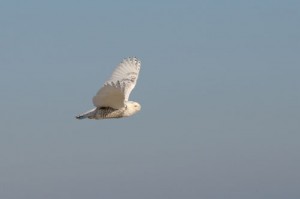
ASSATEAGUE — The first snowy owl fitted with a transmitter on Assateague Island has been a busy bird, according to data collected to track his whereabouts over the last week or so.
Local residents and visitors to beaches in Maryland and Delaware over the last few weeks have been treated to a rather rare opportunity to see snowy owls up close and in person as the Arctic visitors have flocked to the mid-Atlantic’s coast as well as inland areas. Their visit is called an “irruption” in scientific terms, and while they are fairly common for many species of migratory birds, the ongoing irruption of snowy owls in the local area has been particularly noteworthy and is being referred to in some circles as a natural history event.
Scientists are seeking answers for the unusual irruption of snowy owls and are trying to gain a better understanding of the migration patterns of the large and beautiful birds. To that end, some of the birds have been briefly captured and fitted with a lightweight, solar-powered transmitter allowing scientists and bird-watching enthusiasts to track their movements.
The first snowy owl fitted with a transmitter during what is now being called Project SNOWstorm was tagged on Assateague last week. In the days since, the tagged snowy owl has been tracked from Assateague to Delaware to ultimately the Jersey shore. As of early this week, the snowy owl fitted with a transmitter on Assateague was taken up residence in Cape May.
“The owl that was tagged on Assateague has since flown to Cape Henlopen, where it spent some time on the lighthouse, and then continued across the Delaware Bay to the mouth of a tidal creek in Cumberland County, N.J.,” said David La Pluma, a product specialist with Leica Sport Optics, which is tracking the data. “This represents only two days of data. Can you imagine what we can learn with dozens of marked owls over the course of a year or more?”
Currently, Project SNOWstorm has five transmitters to put on snowy owls, which could expand the effort to track their movements and gain a better understanding of the ongoing irruption, according to Carrie Samis, education coordinator with the Maryland Coastal Bays Program.
“One bird, a hatch-year male, was tagged at Assateague and fitted with a solar-powered transmitter,” she said this week. “Four additional transmitters are ready to be fitted. The field team has been out, on and off, over the holidays to identify birds for tagging, each in different locations.”
Project SNOWstorm researchers David Brinker and Scott Weidensaul recognized the current snowy owl irruption as a unique opportunity to learn more about the birds and helped initiate the tagging program. The effort is gaining momentum across much of the northeast where the snowy owls are appearing in large numbers. Each solar-powered transmitter weighs about 40 grams, which, per scientific protocol, is less than 3 percent of the bird’s body weight, according to Samis.
With one snowy owl tagged on Assateague already and four more transmitters ready for an appropriate host bird, the research team hopes to expand on the program in the coming weeks as the irruption continues. It can cost as much as $3,500 to fit a bird with a transmitter, but the Project SNOWstorm team is expected to launch a fundraising campaign this month to generate funding for more transmitters.
According to Samis, who has been blogging about the owls on the Maryland Coastal Bays Program’s website, the growing team of scientists and researchers are coordinating efforts to collect data from rehabbers across the country when sick or injured birds show up. Additional data may be collected, including blood samples, which can help scientists assess the health status of the snowy owls inundating the area. Identifying individual birds by sex and color pattern will increasingly improve as more birds are documented.
However, there is little evidence to explain the current irruption of snowy owls across Delmarva and much of the mid-Atlantic region. Adequate food sources are a major factor in changes to migration patterns, but there is little indication food scarcity is driving the current anomaly. Initially, scientists believed a food shortage was driving the birds further south, but the preliminary data is showing this current irruption includes a lot of healthy young birds.
“It seems that this big irruption is driven by excellent reproductive success, not food scarcity,” said Brinker.
In most years, there are irruptions of other migratory birds on Assateague and other beach habitats along the mid-Atlantic, but they go largely unnoticed by non-scientists and non-birdwatchers because they aren’t as readily visible or recognized. Standing about two feet tall and weighing around four pounds and densely covered with thick white plumage, the snow owls easily standout along the local winter landscape.
